Like a craftsman sizing up raw steel, you’ll need clear numbers before you strike an arc. You can expect startup costs anywhere from roughly $1,090 to $18,230 for equipment and safety gear depending on machine type, PPE, and consumables; adding formal training can increase the total investment further. This range reflects choices that directly affect safety, compliance, and productivity, so you’ll want a precise breakdown to plan effectively and avoid costly gaps.
Key Takeaways and Startup Estimates

If you’re planning to start welding, expect a basic, functional setup to cost roughly $700–$2,500 depending on the machine and accessories you choose; that estimate covers a welder, essential safety gear, and common consumables.
You’ll allocate funds across three categories: the welder, safety apparel, and consumables. Plan $100–$300 for gloves, glasses, and protective clothing, and $140–$230 for filler rods, wire, tips, and shielding gas where applicable.
Entry-level stick units start near $100; MIG units—common for beginners—typically sit between $200 and $2,000; TIG units, for high-precision work, begin around $500 and rise above $5,000 for advanced models.
When budgeting, match equipment choice to intended welding techniques and anticipated material costs. This structured estimate helps you make standards-aligned purchases and prepares you for progression: a modest initial investment supports skill development and opens measured career opportunities in fabrication, maintenance, and specialty welding roles.
Types of Welding Machines and Price Ranges

You’ll choose between MIG, TIG, stick, or multiprocess machines based on the precision, material thickness, and environments you’ll work in.
Expect MIG units from about $200–$2,000 for general-purpose use, TIG from $500–$5,000+ for thin-material precision, and stick welders at $100–$1,000 for outdoor and heavy-duty tasks.
If you need versatility, budget $1,000 to over $10,000 for multiprocess systems that combine MIG, TIG, and stick capabilities.
MIG Machine Costs
One clear way to budget for welding is to look at MIG machines, which span roughly $200 to $2,000 depending on capacity and features.
You’ll find entry-level units near $300 suited for hobbyists and light repair; they support basic MIG welder features like adjustable voltage, wire-feed control, and thermal overload protection, which are enough to learn MIG welding techniques.
Mid-range models ($300–$1,500) offer better duty cycles, smoother arc control, and multi-gas capability for steel, aluminum, and stainless steel.
Industrial-grade welders above $1,000 add durability, higher duty cycles, and advanced controls for sustained production.
For most general-purpose needs, allocate $300–$1,500 to get a reliable, standards-compliant MIG setup without overspending.
TIG Machine Pricing
After covering MIG options, consider TIG machines when you need finer control and cleaner welds on thin materials.
You’ll find TIG welders priced from about $500 for entry-level units to over $5,000 for advanced systems. Basic TIG welding setups typically range $500–$2,500; higher-end models justify the cost with superior TIG welder features such as pulse control, AC balance for aluminum, and improved arc stability.
Factor in recurring costs: tungsten electrodes, specialty filler rods, and shielding gases increase total investment.
TIG excels on aluminum and stainless steel, so match machine capabilities to the TIG welding materials you plan to work with.
Assess duty cycle, amperage range, and interface options to guarantee the selected unit meets professional standards and project demands.
Multiprocess & Stick
When you need flexibility across jobs, multiprocess welders combine MIG, TIG, and Stick functions into a single unit, with entry-level models starting around $1,000 and professional systems climbing past $10,000 depending on amperage, duty cycle, and control features.
You’ll appreciate multiprocess advantages when shop requirements vary: one machine reduces footprint, simplifies inventory, and enforces consistent control standards across processes.
Choose a unit by rated output, duty cycle at intended amperage, waveform control (for TIG/MIG), and portability.
Separately, stick welders remain the most affordable—$100–$1,000—and you’ll select them for specific stick welding applications like thick steel and cast iron, outdoor or dirty surfaces, and field repairs where simplicity and robustness outweigh process versatility.
Essential Personal Protective Equipment Costs
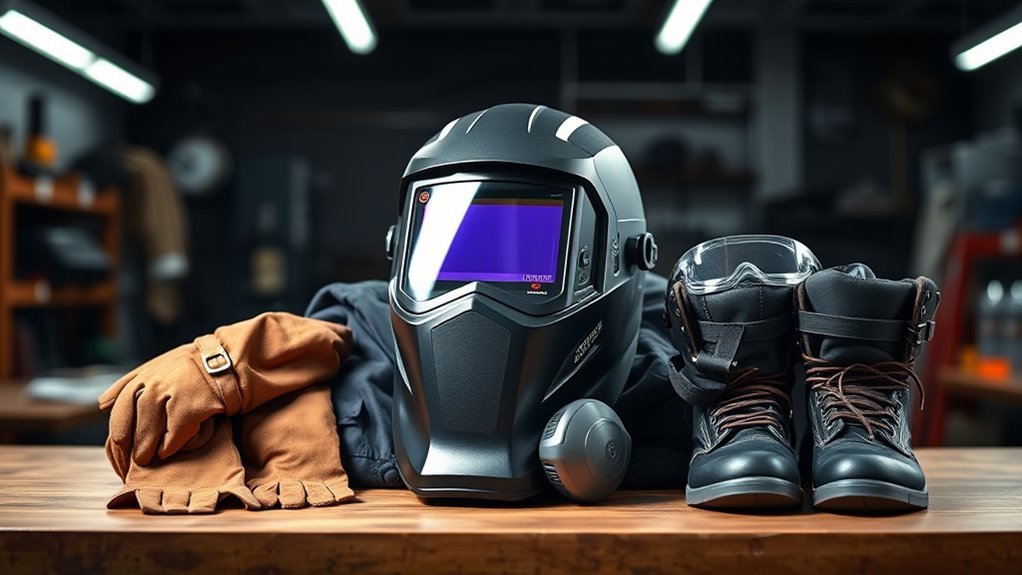
Now that you’ve looked at machine costs, you’ll need to budget for basic PPE items—cotton or wool pants ($20–$60), a wool or cotton shirt ($15–$50), steel-toed boots ($50–$150), gloves ($10–$50), and safety glasses ($5–$30).
Don’t forget respiratory protection for fume control and hearing protection for prolonged noise exposure, both of which add modest but essential expense.
We’ll quantify recommended models and expected price ranges next so you can plan to meet safety standards precisely.
Basic PPE Items
Start by budgeting roughly $250–$600 for a basic welding PPE kit, since adequate eye, head, hand, body, and foot protection is nonnegotiable.
You’ll prioritize welding safety by selecting certified PPE materials: safety glasses ($10–$30) that meet impact standards, welding gloves ($20–$50) rated for heat and abrasion, and fire-resistant clothing—jackets or shirts in cotton or wool—priced $50–$150.
Choose garments with reinforced seams and appropriate ISO/ANSI ratings. For foot protection, pick steel-toed boots ($50–$200) with heat-resistant soles.
Total cost varies with brand and durability, but investing in mid- to high-quality items reduces replacement frequency and meets workplace standards.
Document specifications and receipts to verify compliance with shop or regulatory requirements.
Respiratory and Hearing
You’ve covered eye, hand, body, and foot protection; next you should budget for respiratory and hearing gear to protect lungs and ears from fumes and noise. You’ll follow respiratory standards and hearing conservation protocols to choose appropriate equipment. Expect N95s at $1–$5 each; cartridge respirators $20–$200; filters $10–$50/month. Earplugs and earmuffs cost $1–$30; custom hearing protection runs $150–$300. Initial total commonly falls between $50 and $500+, depending on quality and project needs. Prioritize fit testing, replacement schedules, and documented hearing conservation measures to prevent long-term health costs.
| Item | Typical Cost | Notes |
|---|---|---|
| N95 | $1–$5 | Disposable, limited protection |
| Cartridge respirator | $20–$200 | Reusable, filter dependent |
| Filters/month | $10–$50 | Usage-based recurring |
| Hearing protection | $1–$300 | Includes custom options |
Consumables and Material Expenses
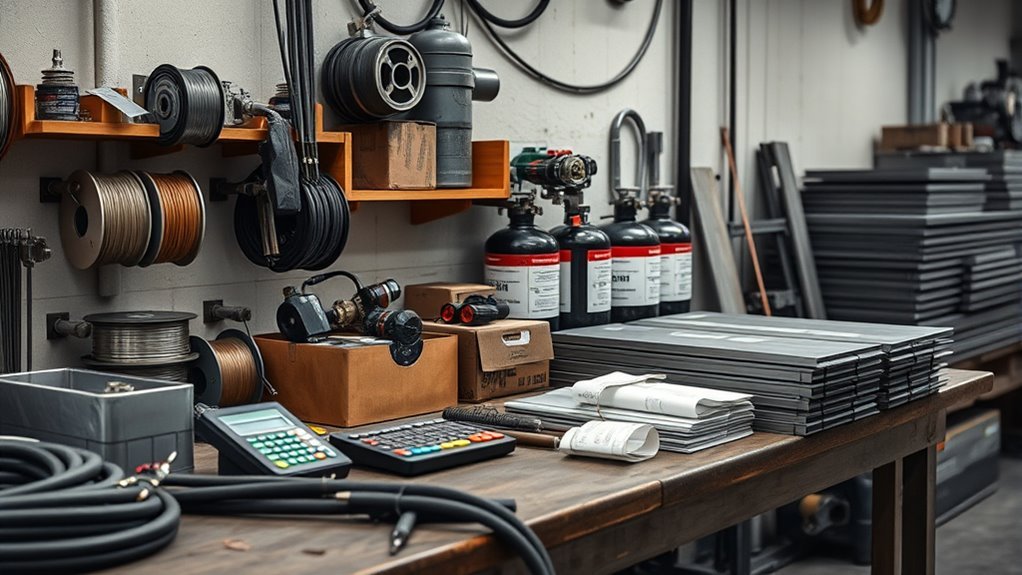
One clear expense to budget for is consumables—welding wire, electrodes, and shielding gas—which typically tack on about $140 to $230 to a project’s material costs.
You’ll include those figures in a concise welding supplies cost breakdown so estimates stay accurate. Base metal costs vary (for example, 14-gauge steel runs $44–$125 per 25-foot stick), and quality filler materials command higher prices because they improve deposition and reduce rework.
Include consumables in estimates — base metal varies (e.g., 14-ga $44–$125/25-ft) and better filler reduces rework.
Shielding gas choice changes both cost and weld integrity, so match gas to process and base metal. For ongoing work, plan regular replenishment of consumables to avoid downtime.
- Welding wire and electrodes — choose grade for process and metal compatibility.
- Shielding gas — specify type and cylinder size for job duration.
- Base metals — record supplier pricing and gauge-specific costs.
- Filler quality — weigh upfront cost against reduced defects and labor.
Track unit costs, consumption rates, and reorder thresholds to maintain precise, standards-focused budgeting.
Tools and Accessories You’ll Need
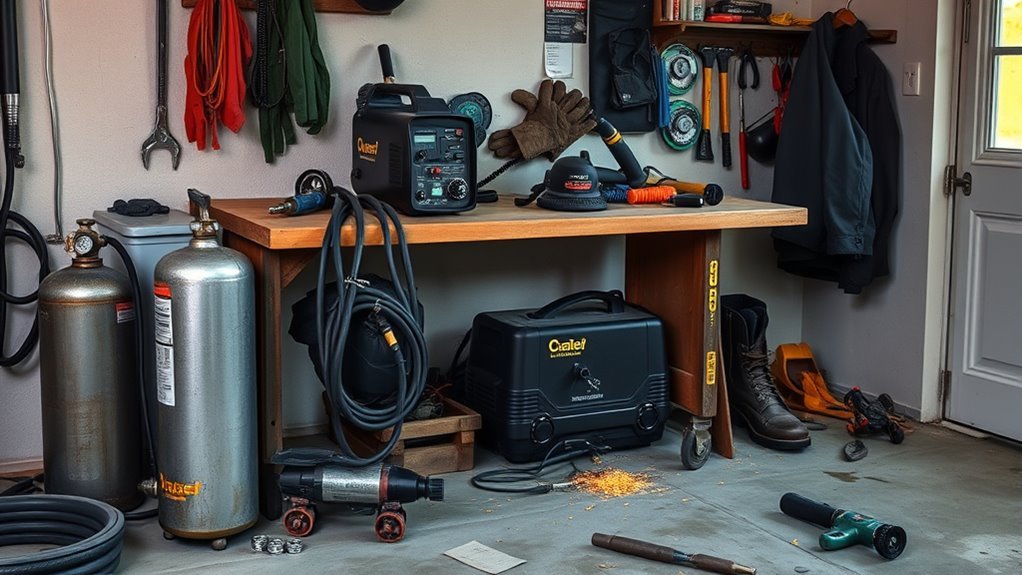
Alongside tracking consumables and material costs, you’ll also need a compact toolkit that supports consistent, standards-compliant welding work: choose a welding machine (MIG, TIG, or Stick) that fits the metals and joint types you’ll run—expect $200–$5,000 depending on capability and duty cycle—then add protective gear (helmet, gloves, steel-toed boots) estimated at $150–$400 (with many auto-darkening helmets alone costing around $100–$300+) and flame-resistant clothing at $50–$150.
You’ll also budget consumables (electrodes, filler metals, shielding gas) at roughly $140–$230 and practical accessories—clamps, carts, protective screens—adding $100–$500.
Select tools that match the welding techniques you plan to use; TIG setups need precise torches and argon allocation, MIG demands wire feeders and contact tips, Stick emphasizes electrode holders and chipping hammers.
Material selection dictates filler metal and shielding choices, so standardize your kit for common alloys to reduce changeover.
Prioritize certified helmets with appropriate lens shade, durable gloves rated for heat and dexterity, and stable work-holding to maintain repeatable, code-compliant welds.
Training, Certification, and Skill Development Costs

Because welding skills and certifications directly affect what jobs you can take and what you’ll earn, plan for training and credentialing costs as part of your startup budget. You’ll choose between short certificate courses and two-year programs ($2,000–$15,000) based on depth, accreditation, and employer expectations.
Apprenticeships provide on-the-job training at minimal cost while you earn, but formal certification testing and fees still apply. Prioritize programs aligned with recognized standards to maximize employability.
- Program cost: community college to trade school, $2,000–$15,000, duration six months–two years.
- Certification fees: testing, retesting, and documentation—vary by certifier and region.
- Apprenticeship/OJT: low-cost practical training while earning a wage; verify credential pathways.
- Continuing education: periodic courses and recertification to maintain compliance and enable skill enhancement.
Treat these expenses as investments in a welding career; certified welders command higher pay and more stable job prospects.
Workshop Setup and Safety Infrastructure
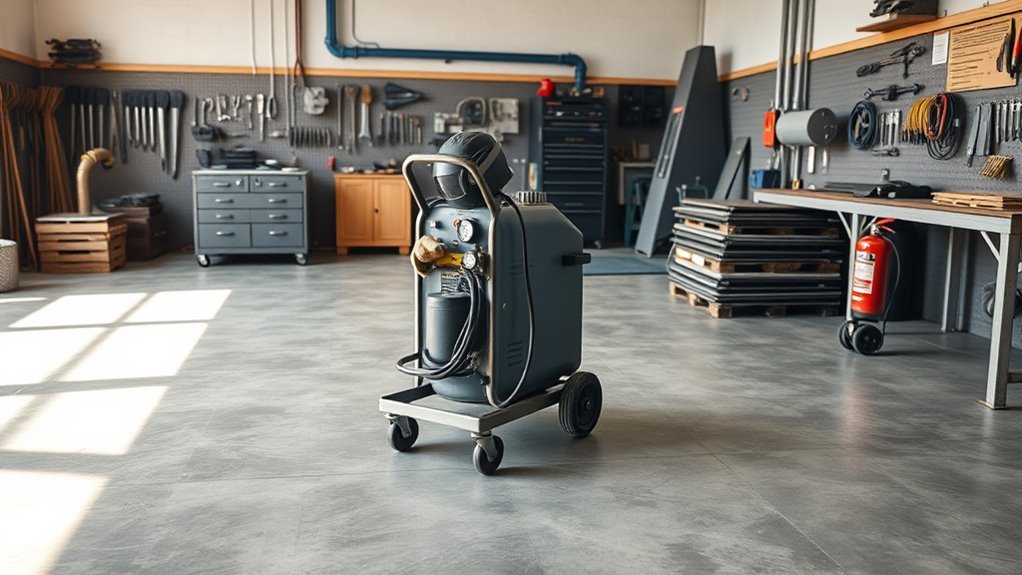
When you set up a welding workshop, prioritize equipment, ventilation, fire-resistant surfaces, and insurance to meet safety and regulatory standards.
You’ll select a welder (MIG, TIG, or Stick) within your budget ($100–$5,000) and acquire PPE—gloves, safety glasses, steel-toed boots—around $100–$300.
Plan welding workspace organization to separate hot work, storage, and access routes; use metal benches and non-combustible flooring to limit ignition risk.
Specify ventilation systems installation: local exhaust hoods, canopy extraction, or high-capacity fans sized to turnover rates that control fumes and particulate.
Install grounded electrical circuits, clear signage, and accessible fire extinguishers (typically ABC-rated, adding Class D units if you weld combustible metals).
Depending on your space, you may also need to budget for electrical work such as adding 240V circuits or upgraded outlets by a licensed electrician.
Document procedures, training records, and equipment specs to satisfy inspections.
Finally, secure liability and property insurance—often around $1,200–$3,000 or more annually depending on your location, revenue, and coverage—aligned with local codes and risk exposure.
These measures support compliance, reduce incidents, and establish a professional, standards-aligned workshop from day one.
Ongoing Operating and Maintenance Expenses
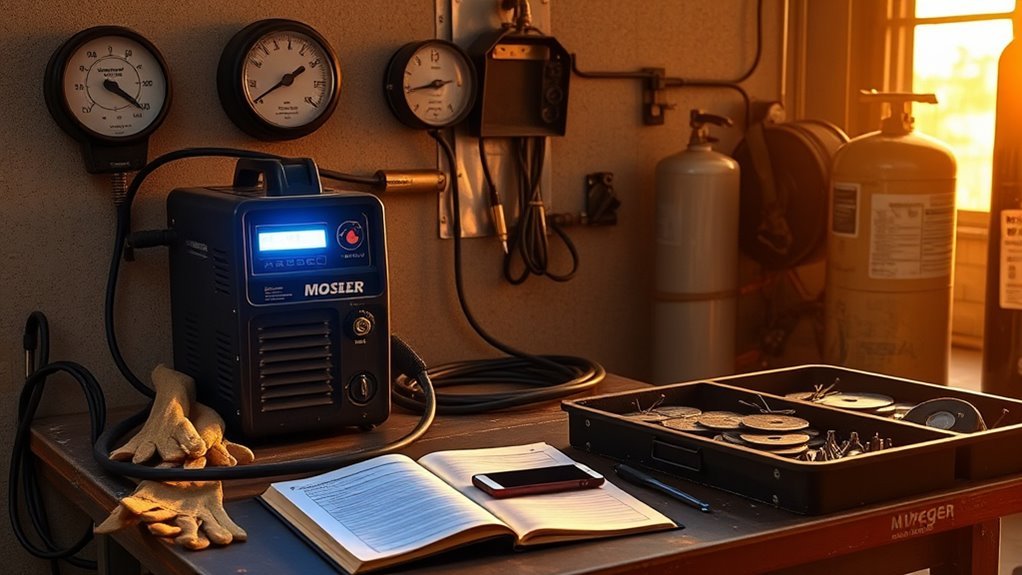
Although initial capital outlays get the most attention, ongoing operating and maintenance expenses determine your shop’s true cost of ownership, so you should budget for predictable recurring charges and occasional repairs.
You’ll track electricity consumption—welders and ancillary equipment can drive a large portion of monthly utility bills—so monitor loads to protect operational efficiency.
Consumables (wire, electrodes, shielding gas) typically add $140–$230 to material costs; include that range per project or month as appropriate.
Plan for ventilation system upkeep and PPE maintenance to meet safety standards.
- Electricity: monitor kWh use and bill impact, adjust schedules to control peak demand.
- Consumables: budget $140–$230 for routine material replenishment per relevant period.
- Equipment maintenance: schedule preventive servicing and MTTR targets; factor repair reserves.
- Training and safety: invest in operator training to reduce failures and support maintenance scheduling.
Be precise with records, implement maintenance scheduling, and treat these items as fixed-line costs for accurate forecasting.
Budgeting Tips and Cost-Reduction Strategies
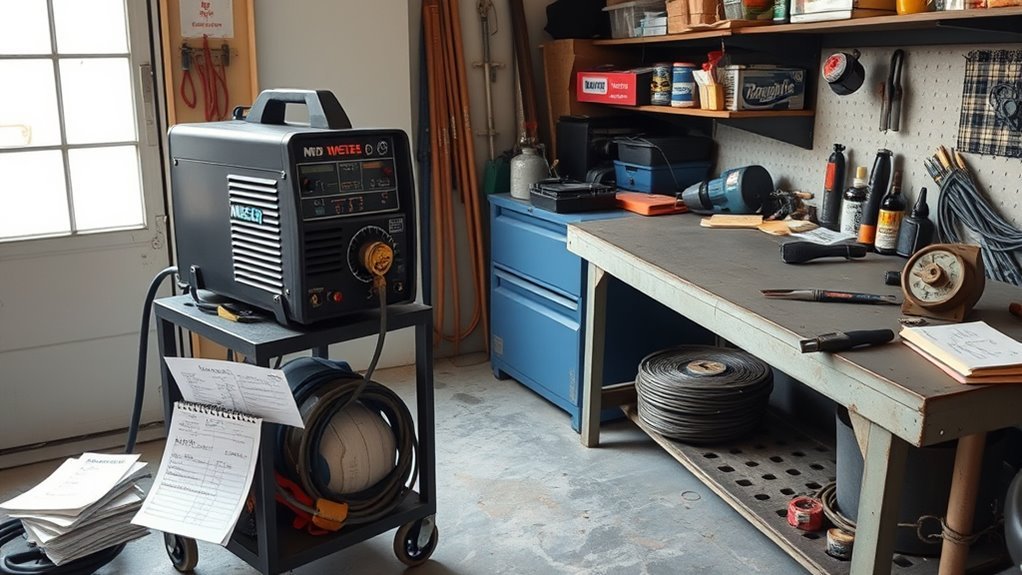
If you want to keep startup and operating costs manageable, build a detailed budget that covers everything from a $100 basic stick welder up to $10,000+ multiprocess units, plus accessories, installation, and safety gear.
Use budgeting strategies that begin with a thorough cost analysis: list initial equipment, consumables, training, installation, and PPE. Compare new versus inspected used equipment to reduce capital outlay, but require safety-standard checks to avoid hidden repair costs.
Contact multiple local suppliers, document unit and bulk prices for filler metals and shielding gases, and calculate per-hour consumable rates. Include recurring expenses—gas refills, maintenance, and refresher courses—in your monthly projections.
Join trade associations or local groups to access discounts and vetted supplier lists. Revisit your budget quarterly, updating actuals against projections to refine forecasts and prioritize purchases.
This standards-focused approach keeps finances controlled, minimizes surprises, and supports compliance with safety and performance requirements.
Frequently Asked Questions
Do Welding Businesses Need Specific Insurance Coverage Beyond General Liability?
Yes — most welding businesses benefit from specific insurance coverage beyond general liability. You may require policies addressing equipment, professional liability, workers’ compensation, and commercial auto to meet insurance requirements and mitigate business liability risks and regulatory obligations.
Can I Finance Welding Equipment Purchases or Lease Instead of Buying?
Like Odysseus choosing a new course, you can finance welding equipment or use leasing options; equipment financing gives ownership and tax benefits, while leasing options lower upfront cost and can provide predictable, standards-focused upgrades and maintenance.
How Do Local Zoning Laws Affect Home-Based Welding Shops?
Local zoning regulations can restrict your home business by limiting allowable activities, noise, emissions, hours, signage, parking, and equipment use; you’ll need permits, inspections, compliance with safety codes, and possibly variance approval before operating.
Are There Environmental Regulations for Welding Fumes and Waste Disposal?
Yes — in many regions, you may face strict rules: welding emissions limits, monitoring, and certified ventilation requirements, plus waste management protocols for sludges, solvents, and contaminated consumables. You must document compliance, train staff, and keep inspection-ready records.
What Tax Deductions Apply to Starting a Welding Business?
You can often deduct qualified business expenses like equipment, supplies, safety gear, training, shop rent, utilities, insurance, and vehicle costs; track receipts, separate personal spending, and, where applicable (such as under U.S. tax rules), use Section 179/bonus depreciation with an accountant’s guidance.
Conclusion
You’ll likely need $1,090–$18,230 to start welding, depending on whether you buy basic gear or professional kit and whether you include formal training in your initial budget; plan for machines, PPE, consumables, training, and workspace safety. For example, a hypothetical startup—buying a $1,200 MIG welder, $400 PPE, $800 tools, $500 initial consumables, and $2,500 part-time certification—invested $5,400 and reached breakeven in six months in this example; actual timelines vary by market conditions and workload. Stick to standards, document expenses, and update PPE regularly.


